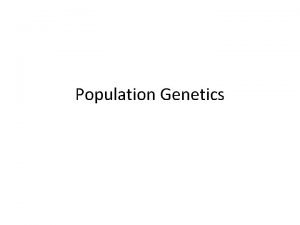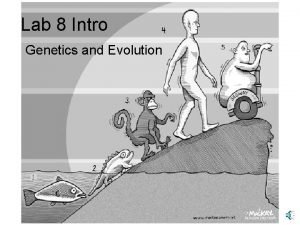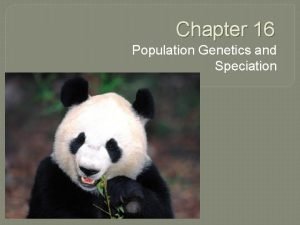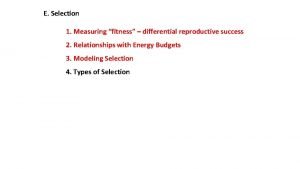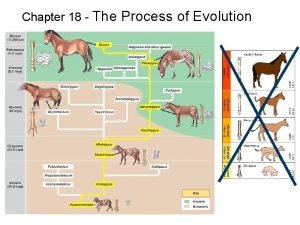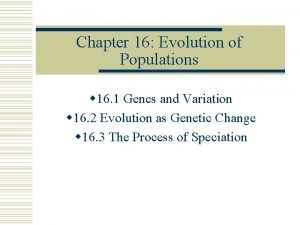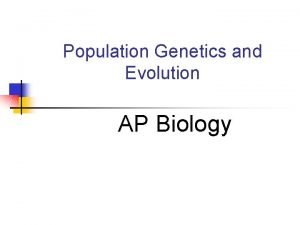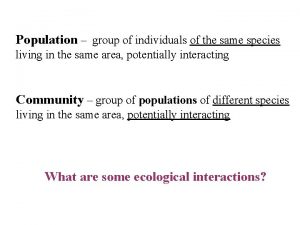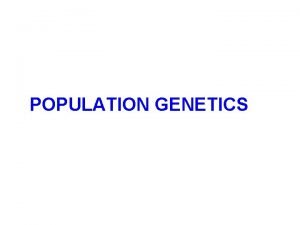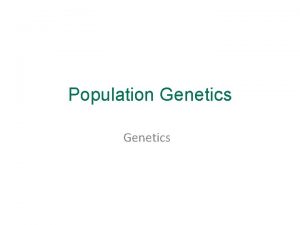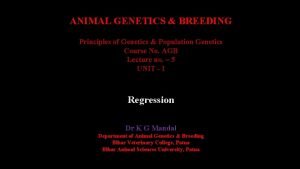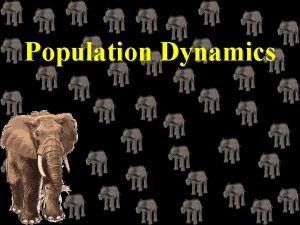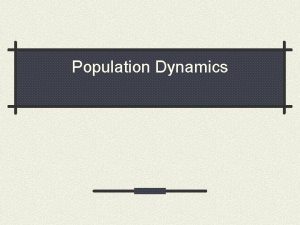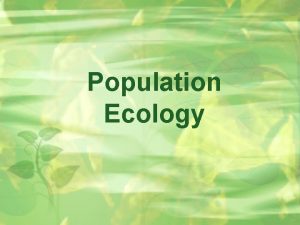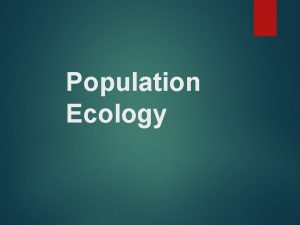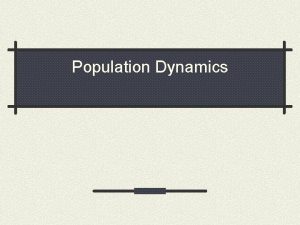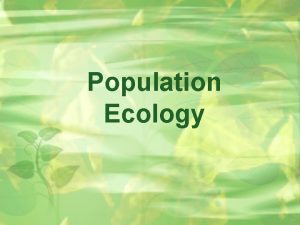Population Genetics Population group of individuals of the















- Slides: 15

Population Genetics Population: group of individuals of the same species. Concept of gene pool. Analyses the amount and distribution of genetic variations and the forces that control this variation

Genetic polymorphism • Morphologic. • Proteinic. • Inmunologic. • Chromosomic. • At DNA level. Haplotype: set of alleles on a chromosome fragment

Allele and genotype frequencies We can describe the variation in a population in terms of genotype and allele frequencies Genotypes AA Aa aa Number 50 80 30 Genotype frequencies Allele frequencies f(AA) = 50/160 = 0, 3125 f(Aa) = 80/160 = 0, 5 f(aa) = 30/160 = 0, 1875 f(AA)+f(Aa)+f(aa) = 1 Frequency of A: p = f(AA)+1/2 f(Aa) = 0, 5625 Frequency of a: p = f(aa)+1/2 f(Aa) = 0, 5625 p+q = 1

The Hardy–Weinberg principle - Next generation f(AA) = p 2 f(Aa) = 2 pq f(aa) = q 2 p 2 + 2 pq + q 2 = 1 -Mating is random -Genotypes have same viability -No subpopulations isolated -Infinitely large population -Hardy-Weinberg equilibrium: - Frequencies do not change over the generations

Uses of Hardy–Weinberg law In Africa, albinism is as frequent as 1/1100. Which is the frequency of the allele in the population? f(aa) = q 2 = 1/1100 = 0, 0009 q = 0, 0009 = 0, 03 p = 1 -q = 0, 97 Which is the frequency of the heterozigous? f(Aa) = 2 pq = 0, 06 Is a given population in equilibrium? Genotypes A/A A/G G/G Number 17 55 12 p = f(A/A) + ½ f(A/G) = 0, 53 q = f(G/G) + ½ f(A/G) = 0, 47 Use of p 2, 2 pq and q 2 to calculate the 2 statistic Expected 23, 57 41, 85 18, 57 84 (O-E)2/E 1, 83 4, 13 2, 33 8, 29 P<0, 005 and degrees of freedom: 3 -2 = 1 Two parameters from sample: total number and p (not q, since p+q=1) 8, 29>3, 84 NO EQUILIBRIUM

Homozygote and heterozygote frequencies depend on allele frequencies

Mating systems • Random mating: critical for Hardy-Weinberg equilibrium • When the mating is not random: • Assortative mating: when the individual chooses mates based on resemblance • Negative • Positive • Distance: individuals more apt to mate with a neighbour • Inbreeding: mating between relatives • More likely to be homozygous: Inbreeding depression

The inbreeding coefficient (F) • The probability that two alleles in an individual track back to the same copy in a common ancestor • Probability of I receiving red allele thru C: 1⁄2× 1⁄2 • Probability of I receiving red allele thru B: 1⁄2× 1⁄2 • Same for blue allele • FI=(1⁄2× 1⁄2)+(1⁄2× 1⁄2)=(1⁄2)3=1⁄8 • If A has some inbreeding, the probability of giving the same allele is 1⁄2 +1⁄2 FA • General equation. n is the number of ascendants in the loop FI = (1/2)n (1+FA) loops

Calculating inbreeding coefficient from pedigrees • Identify individuals which can give same allele to descendant • Identify individuals who must transmit those alleles • Assign letters to individuals • Draw closed loops of inbreeding • Daughter of first cousins • Suppose FA and FB 0, if not known

3. 2 Evolutionary Genetics • Forced than modulate amount of genetic variation in populations • How do new alleles enter the gene pool? • What forces remove alleles from the gene pool? • How can genetic variants be recombined to create novel combinations of alleles? • Alleles frequencies cannot be constant all the time to allow evolution • Basis for understanding the process of evolution • Mutation • Migration • Recombination • Genetic drift • Natural selection

Mutation • Mutation rate: probability that a copy of an allele changes to some other allelic form in one generation μ A→a • f(A) in generation t = pt. In the previous generation = pt-1 • The change of frequency of A in one generation will be Δp=pt −pt− 1=(pt− 1−μpt− 1)−pt− 1=−μpt− 1 • For a number n of generations pn = p 0 e−nμ

Migration • Species are divided into small, local populations or subpopulations • Physical barriers reduce gene flow between subpopulations • Isolated populations tend to diverge since each one accumulates different mutations • Migration from one subpopulation to another with different alleles frequencies results in a new population with intermediate frequencies between the two populations

Natural Selection • Explanation for adaptations: Charles Darwin, “survival of the fittest” • Individuals with certain heritable features are more likely to survive and reproduce than others • Fitness (W) measures the number of offspring an individual has, relative to the most fit individual • W=0, no offspring; W=1, the highest number of offspring • Selection changes allele frequencies because some genotypes contribute more alleles to the gene pool than others

Speciation needs reproductive isolation • Species: group of interbreeding organisms that is reproductively isolated • Most population contains considerable genetic variation (alleles or allele frequencies) • Natural selection and genetic drift add variation • Migration reduces variation • Reproductive isolation mechanisms prevent or reduce interbreeding between populations

Genetic differences can be used to reconstruct evolutionary history • Fitch and Margoliash (1967): sequence date from cytochrome c • Construct a tree using the minimal mutational distance among species • Protein involved in respiratory chain, evolves very slowly • Molecular clocks: protein or DNA sequence, where evolutionary changes accumulate at constant rate over time • Difficult to find
 Genetics
Genetics Lab 8 population genetics and evolution
Lab 8 population genetics and evolution Population genetics and speciation worksheet answer key
Population genetics and speciation worksheet answer key Population genetics
Population genetics Population genetics
Population genetics Population genetics
Population genetics Genetics
Genetics Group of individuals of the same species
Group of individuals of the same species Chapter 4 population ecology section 1 population dynamics
Chapter 4 population ecology section 1 population dynamics Population ecology section 1 population dynamics
Population ecology section 1 population dynamics Population ecology section 1 population dynamics
Population ecology section 1 population dynamics Section 1 population dynamics answer key
Section 1 population dynamics answer key Hát kết hợp bộ gõ cơ thể
Hát kết hợp bộ gõ cơ thể Slidetodoc
Slidetodoc Bổ thể
Bổ thể Tỉ lệ cơ thể trẻ em
Tỉ lệ cơ thể trẻ em
